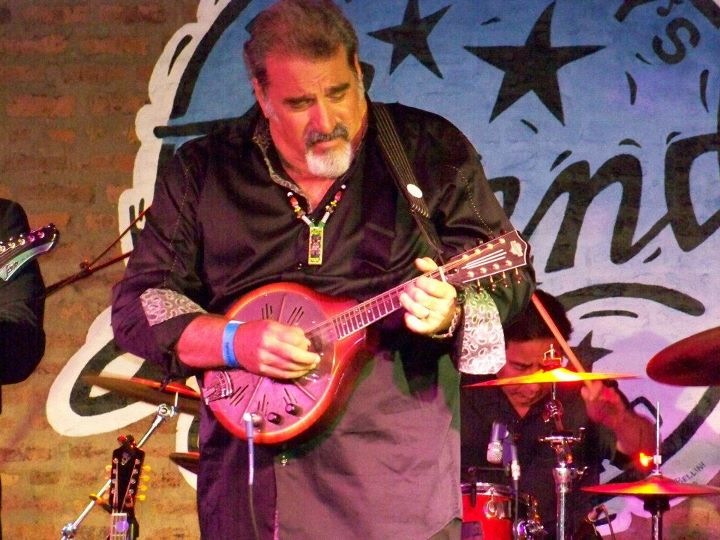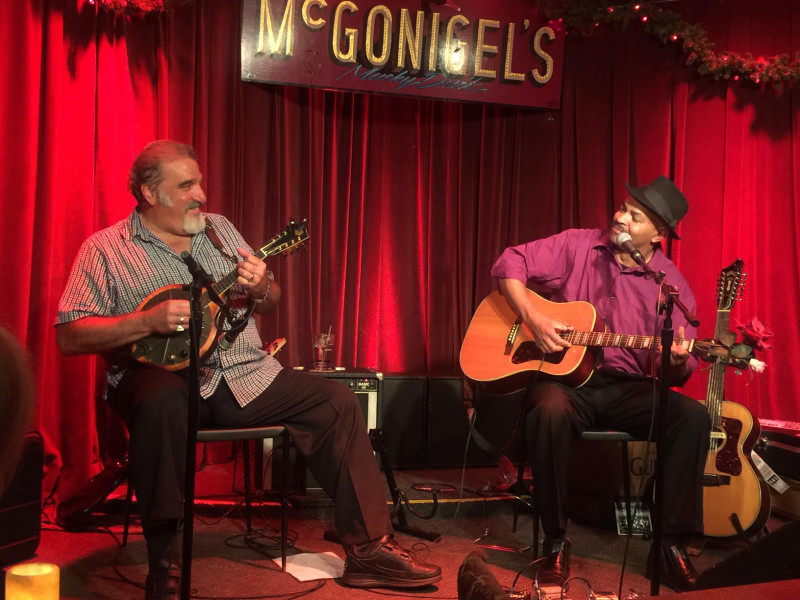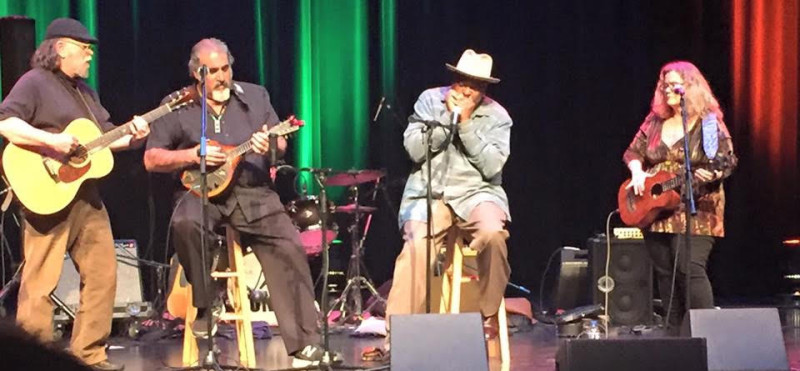
Way down in Houston, Texas, there is a swift blues mandolin maestro. He nowadays stays mostly close to home, but he’s world renowned as one of the significant devotees to the little instrument that was so prominent in the early days of the blues. Nowadays the mandolin is mostly connected to bluegrass and new-grass, but who could forget the great blues of Yank Rachell?
The mandolin has a rich and vivid history in the country blues. Today, the blues mandolin tradition carries on with the likes of Ry Cooder, Steve James, Andra Fay, Billy Flynn and Bert Deivert in, Sweden. Back in the day, the mandolin was part of the blues string ensembles like the Memphis Jug Band and the Mississippi Sheiks. Vol Stevens, Will Weldon, Eddie Dimmitt and Charlie McCoy were some of the best at the time. At the Stovall plantation in Mississippi Muddy Waters played with mandolinist Louis Ford. Later, Muddy played with mandolinist Johnny Young in Chicago’s Southside. Of course, the famous Yank Rachell was a key element in Sleepy John Estes ensemble.
The countryblues.com caught up with the renowned and award-winning mandolin picker and fellow scribe who used to write for Blues Revue andMandolin Magazine. He is a skilled graphic artist and a teacher who has written a series of Hal Leonard Mandolin Method instructional books. He has even taught numerous seasons at David Grisman’s prestigious mandolin symposium in Santa Cruz, California. If there is one guy in America who devoted his entire career to focusing on the great country blues mandolin tradition it is Rich DelGrosso. Among his musical activities is his recent work with the celebrated and critically acclaimed Ragpicker’s String band trio, with guitarist Mary Flower, and multi-instrumentalist Martin Grosswendt. He told us his own remarkable story, including working with golden era masters like Yank Rachell and Howard Armstrong.
Rich DelGrosso:
“I’m getting older, and I’ve reached a tipping point as far as touring and doing that life anymore. It’s no longer comfortable. I’m doing a lot of teaching, local gigs, local meaning Texas, Louisiana, primarily. I don’t like flying any more.
One of my great memories as a mandolinist was in Italy teaching for Carlo Aonzo and his Accademia Internazionale Mandolino Italiano. That was a classical mandolin camp that he puts together in Europe. (As an Italian American), it was wonderful to work in Italy but also then spend time with my family. So that was a double treat there.
I first got into the blues while living in Detroit. I was playing guitar when I was in high school. At that time, it was rock ‘n’ roll. I had a garage band playing Rolling Stones, Cream and Led Zeppelin. I realized that some of the recordings, especially of Cream, the credits were not to Eric Clapton but to somebody named McKinley Morganfield whose stage name was Muddy Waters. Cream’s famous song “Crossroads” is a Robert Johnson song. As I started digging up their music and found it really worked well for blues guitar – much better than the rock ‘n’ roll. So, I got hooked on playing guitar in the prewar style, Muddy Waters and Robert Johnson.
During a trip to Italy with my family I saw an old Neapolitan mandolin. I hadn’t tried mandolin before. I brought it home and I taught myself to play, because there was nobody teaching mandolin back then. I picked up books and I started learning to play by playing old-time music and Celtic music. There was an Irish community in Detroit, so I’d sit in and jam with them and learn fiddle tunes.

Mandolin Magazine and he turned me on to Yank Rachell, who was living near Indianapolis on the family farm. I met up with him and he taught me a whole lot. I learned so much from him including how to get away from the rulebook. Some of his recordings were in the key of E, and I thought, man, you can’t get those open notes and sounds like that in the key of E. How did he do it? I went to visit him we were playing and he said, “Here, let’s trade mandolins” — because I had an old Gibson and he liked to look at that and he wanted to try it. As we traded mandolins I realized he was retuning the mandolin down a step and a half, and that his lowest note was E. But he tuned to fifths from there. When he played what we would call the key of G – if you just strum a big open G chord, his mandolin would sound open E. That was advantageous for him because he was working a lot with guitarist Sleepy John Estes and who preferred to play in the key of E. The other thing I learned from Yank is that he had a whole different picking style. I put a lot of this stuff into my book Mandolin Bluesfor Hal Leonard. His picking style was predominantly upstroking instead of down. I asked him about it, He said, “I stroke. I don’t frail.” And of course frailing is that – must have come from the banjo players that frailed. Frailing is a banjo style where they pluck down with their fingertips down on the strings, sort of like the back of their fingers down on the strings. That’s where he thought the down-picking on the mandolin was frailing. I started doing it for myself, it really makes a difference. It changes the hierarchy of tones in a chord, ie. playing a doublestop on the G and D strings, when picking down, the G is predominant, picking up the D is predominant. And that makes a difference.It’s really powerful.
Howard Armstrong was also a mentor of mine. In his early career, he acquired the name “Louie Bluie.” He’d introduce himself as Louie Bluie. A woman in a bar named him that. I discovered that he was living in Detroit in a home for assisted living downtown. I just called him up one day and I said, “I’m a mandolin player and I’d love to meet you.” I saw him earlier at a folk festival in Toronto with Carl Martin, his brother L.C. and Ted Bogan– Martin Bogan and the Armstrongs. They were billed as the last of the Mississippi string bands. And they were hot. Just great. They were old guys, but they were cooking. Carl Martin was a great mandolin player too. Howard Armstrong played mandolin and fiddle with the band. I never got to meet Carl. He passed away before I could meet him. Howard and I got together and we had some times. After a while Maureen and I would take him out on our gigs and have him join us. We started booking gigs for primarily him, because he was legendary in the folk scene. He was also a really fine graphic artist, and I’m a graphic artist myself, and – but not like him. We had wonderful times together.
I had a thrill many years ago when I was at a blues festival in Fort Lauderdale, on the bill with the Chicago Blues All-Stars which consisted of Carey Bell who played harmonica, Bob Margolin who played guitar, Hubert Sumlin who played guitar and Pinetop Perkins who played piano. All those guys all used to work with Muddy Waters. They invited me up on stage, and they called me up again at the Johnny Johnson Festival in Morgantown, West Virginia. Johnny Johnson was the bandleader for Chuck Berry. I should say Chuck Berry played guitar for Johnny Johnson. That’s where the song “Johnny B. Goode” comes from, is Johnny Johnson. There was a festival dedicated to him, and the Chicago Blues All-Stars got me up on stage again. It was such an honor to be recognized by them. Carey Bell almost made me cry because after I played he leaned into me and he said, “Man, you play like Johnny Young.” To have these icons of the blues, accepting me, was such a treat. I’ll never forget that.

I coordinated the Augusta Heritage Center-Bluesweek in Elkins West Virginia. I brought together a great team of country blues performers and teachers for a week-long program of blues study. These were times l will never forget; very special weeks sharing music, stories and laughter with truly amazing people like John Cephas, Phil Wiggins, Howard Armstrong, John Jackson, Sparky Rucker, Ann Rabson, Gaye Adegbalola, Andra Faye, to name a few. Many, many stories to tell!
When I fell in love with the mandolin, I was already in love with the blues. When I found that black players have been playing blues on the mandolin since the 1920s, that just made my life. I tried gathering all that I could and stockpiling it and writing about it and using it. Basically, I am keeping their tradition alive. Since I started, there have been quite a few other players now that have picked up the mandolin. Some of them are my students and others I had not met until I toured.I have a lot of gratitude that I’ve been able to keep the mandolin alive in the blues and – or the blues alive on the mandolin. It’s been a calling and the highlight of my whole life.”
